A well-maintained pond adds a beautiful touch to any garden. Not only does it create a focal point, adding interest to the landscape, it also attracts wildlife and can be beneficial to the environment.
Water conservation
Did you know that while you’re relaxing, your pond can benefit water conservation? It will re-fill naturally with rainwater, so the surrounding plants will virtually water themselves.
A pond is self-sustaining, so you rarely need to top up the water level. Hydration in the surrounding area can keep your greenery alive and you will seldom have to get out the hosepipe or watering can.
Pond plants
There are many pretty plants that will grow well in or around your pond. These include Creeping Jenny, which fares very well around the water. It grows to about two inches tall and is a great filler, softening the appearance of the rocks, thanks to its bright leaves and yellow flowers. It will bloom throughout the summer.
Cardinal flowers, with their distinctive deep red blooms, can be planted around the shallow edges of your pond. The burgundy foliage complements the red flowers and the leaves will grow to around eight inches long, while the plant can grow up to three feet tall.
Water lettuce will grow in the middle of your pond and produces lime-green, circular clusters of leaves that resemble small, floating heads of lettuce. They are easy to cultivate. All you have to do is allow the plant to float on the pond’s surface, with its roots dangling in the water below. This hardy species produces smaller plants during the summer months.
Wildlife haven
One of the main benefits of having a pond is that it attracts and supports wildlife. Your pond can be a man-made haven for beautiful fish, such as goldfish and Koi carp, but it will also attract local wildlife, which can be entertaining to watch. It will support the wild creatures in their natural environment.
Dragonflies might arrive at this time of year. According to the British Dragonfly Society, the insect is losing much of its natural habitat, as it spends most of its life in water as larvae, but over the past century, an estimated one million ponds have been filled in. Yet they are essential to the dragonfly’s life cycle, so building a pond will help the species to survive.
Frogs and toads
A pond can be a breeding place for frogs and toads. Baby frogs, known as tadpoles, are a useful inhabitant of your garden pond, as they will eat algae and prevent the water from going green. Adult toads, in particular, have a diet of insects and are useful for controlling them around the water.
Newts are another familiar pond resident. According to the Amphibian and Reptile Conservation Trust, newts tend to breed in ponds that contain plants where they can wrap up their eggs.
They are good for keeping down the excess insect population, as their staple diet includes pond-dwelling species such as water lice, water fleas (known as daphnia), worms, mayfly nymphs and leeches. They will also eat insects that fall into the water such as mosquitoes, beetles, sawflies and ants.
Birdlife
Many species of birdlife are attracted to ponds. If you’re lucky and your pond is large enough, you may find ducks in residence. They will provide hours of entertainment, especially if they have young. In fact, many people choose to keep ducks in their back garden.
Popular breeds include Campbell’s ducks, runner ducks and Aylesbury ducks. These species won’t fly off and won’t try to escape, while they have an almost melodic quack! They are as easy to look after as chickens.
A pond can be a real draw for plenty of birds. Many of the small species that visit our garden, such as sparrows and starlings, will drink and bathe in a small pond that’s not too deep. A larger pond might attract waterfowl or wetland birds.
If you’re trying to attract birds, make sure the pond area is safe. Add plants with low-hanging branches, introduce shallow platforms or logs around the pond where the birds can stop to drink or bathe safely and have sloping sides, so they can scramble out easily. There will be plenty of natural food there for any birds that eat insects.
Educate children
Having a pond can create environmental awareness for the kids. If their interest is grabbed early in life, it will hopefully continue through to adulthood.
Letting children help to plan, build and maintain a garden pond can teach them a sense of responsibility and how a natural ecosystem works. It can help to instil the responsibility we all have to care for our planet.
Kids can find out how a complete, natural ecosystem works, igniting their interest in creating a better future for all Earth’s residents.
When you visit beautiful Pinetum Gardens in St Austell, immerse yourself in a haven of tranquillity and remarkable scenery. Take a stroll in the scenic water garden, where colourful, flowering, giant Gunnera plants abound.
Founded in 1989, the water garden was first planted with vegetables and later, the pond was created solely for the wildlife. It attracts deer, heron, foxes, badgers, rabbits and insects such as dragonflies. Every year, toads, frogs and newts arrive to spawn.
Sitting quietly and reflecting in a water garden is always a soothing and peaceful activity, especially in the warming sunshine, with the bright blue Cornish sky above reflecting in the still water, and the purple beech creating an eye-catching focal point and a splash of colour.
There’s plenty of seating in Pinetum’s water garden, where magnolias and brightly coloured herbaceous plants combine with different species of grass, ferns and bamboo to create a wonderful backdrop.
Stroll around Pinetum’s beautiful grounds, where you’ll find everything from ponds to lakes amid the fragrant gardens and woods. The 30-acre gardens are home to one of the UK’s largest plant collections.

